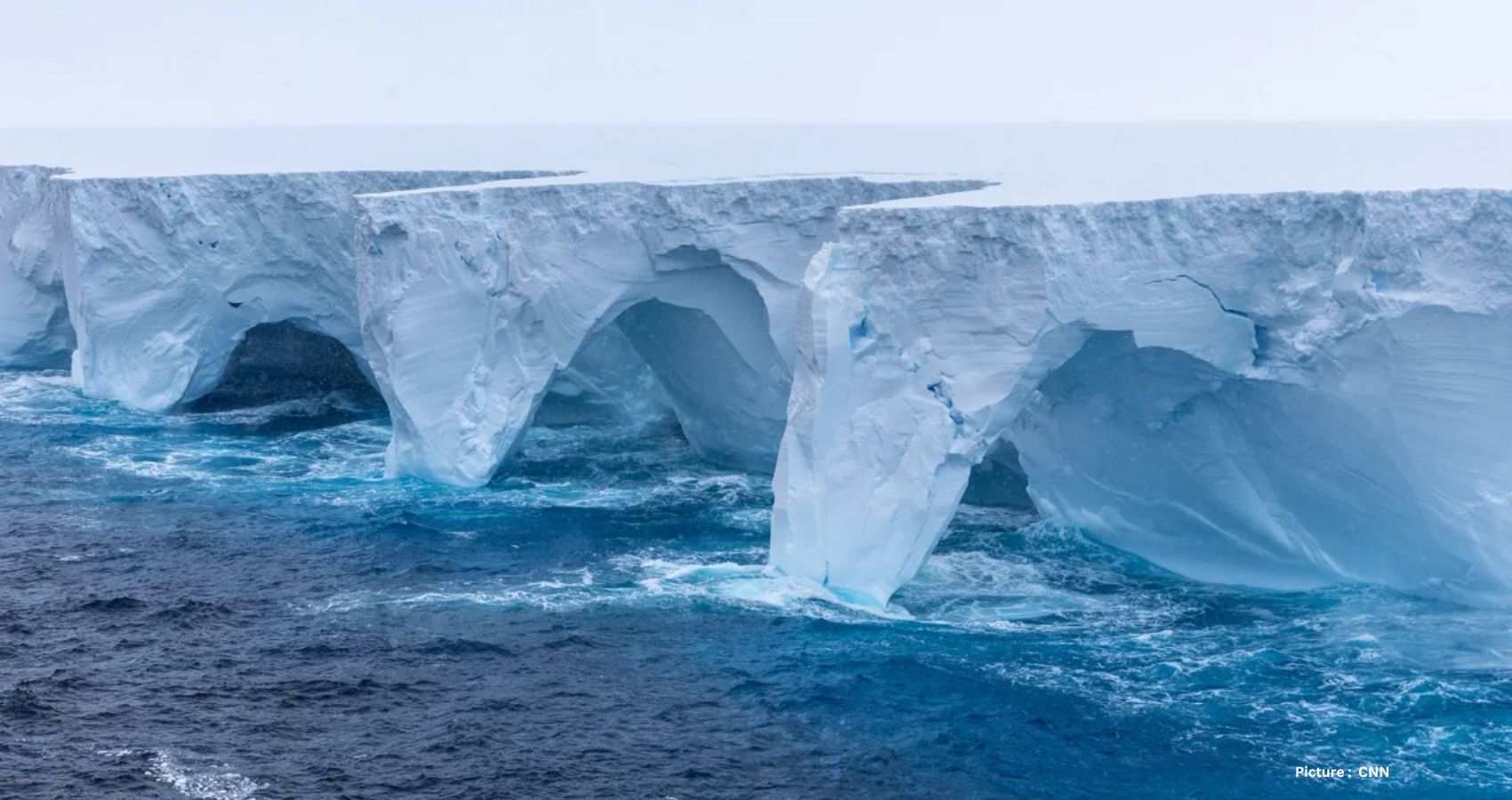Erosion has sculpted massive arches and cavernous hollows into the world’s largest iceberg as it drifts away from Antarctica, as evidenced by stunning new photographs. The captivating images were taken by photographers aboard a vessel operated by EYOS Expeditions, navigating a section of the colossal A23a iceberg. The photos vividly depict the immense scale of the iceberg, surpassing twice the size of London, as it extends into the distant horizon.
The captured images showcase profound surface cracks and intricately carved caves on the iceberg’s surface. The A23a iceberg is undergoing a gradual erosion process as it travels northward from Antarctica, encountering milder air and warmer ocean temperatures. According to a spokesperson from EYOS Expeditions, the expedition team observed chunks of the iceberg breaking off and plunging into the sea.
After nearly three decades grounded on the seafloor in Antarctica, the A23a iceberg is now on the move. Originating from the Filchner-Ronne ice shelf in 1986, the massive ice mass calved and promptly grounded on the Weddell Sea floor in Antarctica. Measuring about 400 meters (1,312 feet) thick and covering an area of nearly 4,000 square kilometers (1,544 square miles), the iceberg is more than three times the size of Los Angeles.
A23a has held the title of the “largest current iceberg” multiple times since the 1980s, occasionally being surpassed by larger but shorter-lived icebergs such as A68 in 2017 and A76 in 2021. The colossal iceberg is destined to eventually vanish completely.
Scientists assert that while the detachment of this particular iceberg likely occurred as part of the natural growth cycle of the ice shelf, climate change is inducing alarming transformations in this expansive and secluded continent, potentially leading to catastrophic consequences for global sea level rise. In February of the previous year, Antarctic sea ice reached its lowest extent since records began, measuring at 691,000 square miles.
The photographs taken during the EYOS Expeditions showcase the dynamic nature of the A23a iceberg as it undergoes erosion and fragmentation. The deep surface cracks and hollowed-out caves on the iceberg’s surface are testament to the transformative effects of its journey away from Antarctica.
The A23a iceberg’s movement is a significant development after nearly thirty years of being grounded on the Antarctic seafloor. Having broken away from the Filchner-Ronne ice shelf in 1986, the iceberg has undergone a prolonged period of stability before its recent drift. The vast thickness of the iceberg, measuring at 400 meters (1,312 feet), adds to its impressive dimensions, making it a formidable presence in the ocean.
EYOS Expeditions, responsible for the captivating photographs, has been actively engaged in exploring the A23a iceberg’s trajectory. The expedition team, witnessing chunks of the iceberg breaking off and entering the sea, provides valuable insights into the ongoing process of erosion. The visual documentation of the iceberg’s transformation serves as a unique contribution to understanding the dynamics of such colossal ice masses.
The A23a iceberg, covering an expansive area of almost 4,000 square kilometers (1,544 square miles), has consistently claimed the title of the “largest current iceberg” since the 1980s. Despite occasional challenges from larger but short-lived icebergs like A68 in 2017 and A76 in 2021, A23a has maintained its position as a prominent feature in the Antarctic landscape.
The inevitable disappearance of the A23a iceberg is a natural progression, considering its detached status and the ongoing erosive forces at play. The iceberg’s journey away from Antarctica, encountering milder air and warmer ocean temperatures, accelerates its deterioration. The visual documentation of chunks breaking off into the sea serves as a poignant reminder of the transient nature of these colossal ice masses.
Scientists emphasize that while the detachment of the A23a iceberg aligns with the natural growth cycle of ice shelves, the broader context of climate change raises concerns for Antarctica. The continent’s isolation and vast expanse make it a critical indicator of climate-related shifts, with potential repercussions for global sea level rise. The visible impact on the A23a iceberg underscores the urgency of addressing climate change to mitigate its far-reaching consequences.
In a broader environmental context, the Antarctic sea ice’s record-low extent in February of the previous year serves as a troubling indicator of changing climate patterns. The extent, measured at 691,000 square miles, marks a historic low point since records began. This alarming trend further underscores the need for concerted efforts to address climate change and its cascading effects on polar regions and, consequently, global sea levels.
The captivating photographs of the A23a iceberg taken by EYOS Expeditions offer a visual narrative of its dynamic transformation as it journeys away from Antarctica. The erosion, surface cracks, and cavernous hollows captured in the images provide a unique perspective on the natural processes shaping these colossal ice masses. As the A23a iceberg continues its drift, scientists emphasize the broader implications of climate change on Antarctica, underscoring the urgent need for global efforts to address and mitigate environmental challenges. The visual documentation of the iceberg’s evolution serves as a poignant reminder of the delicate balance in polar ecosystems and the interconnectedness of climate-related changes on a global scale.

